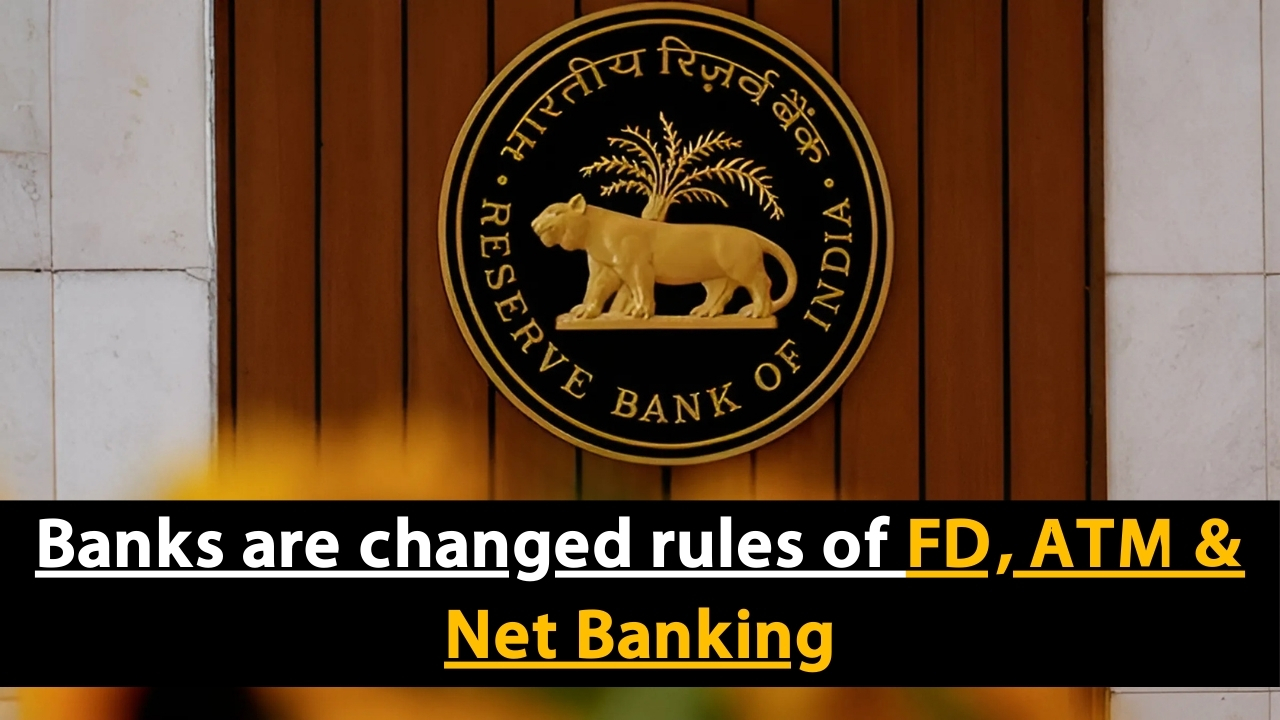FD, ATM & Net Banking : Adding further woes to millions of account-holders across the country, banks have brought new rules for fixed deposits, ATM and internet banking.
These changes (stemming from both regulatory efforts and individual banks’ action plans) mean a very different environment in which to conduct the business of banking on a day-to-day basis.
For people who are used to the status quo of banking – as it has been for decades – it is important to get to grips with the changes in order to save money, access new products and to ensure they have uninterrupted access to banking services.
Table of Contents
FD, ATM & Net Banking Revamping the Fixed Deposit Structure

The fixed deposit market, traditionally dominated by conservative investors and ordinary savers, may perhaps see the most significant policy changes. Several of those changes deserve near-term focus of current and future FD owners:
Penalties for breaking FD Yes, banks redesigned the premature withdrawal penalties across all major banks moving from the earlier flat policy to a slab policy.
According to the modified rules, the penalised amount on premature withdrawal, after 90 days of deposit placement but before the deposit due date, is calculated as 1.5% (for 90 days), 1% (for 91-180 days) and 0.5% (beyond 180 days).
Instead of the old, 1% across the board regardless of the period held penalty, this graduated structure takes its place.
“In fact, the new penalty structure is even more easier on customers who redeem closer to the maturity date because the penalty on the last available redemption date has been completely done away with,’’ said financial analyst Priya Sharma.
“But, early withdrawals in a very early period now taxed much higher, so now most will likely not rush to break ‘promised’ deposit tenures.
Senior citizen concessions have been made much more attractive, where most banks will also give an additional rate of interest premium over and above the normal increase of 0.5%, usually 0.75% for depositors over 60 years.
Some institutions are offering a second tier of 0.85% premium for super-senior citizens aged 80 and above, allowing significantly higher yield improvement to the elderly depositors who need it most.
Tax-saving FD rules now allow people to make partial withdrawals after completion of the 5-year mandatory lock-in period, deviating from the earlier norm where customers could only withdraw post maturity.
These changes preserve the original tax treatment and enhance liquidity in the latter part of the original annuity term.
However, those partial cash-outs are also subject to certain minimum requisites, usually 25% of the amount of the original deposit until it reaches maturity.
Interest calculation method for short term deposits (less than 90 days duration) has been moved to compounding quarterly from the earlier system of simple interest, thereby making short term deployment of funds more lucrative.
Eschewing this seemingly trivial technical detail produces measurable higher returns for depositors with lower tenure.
“It is another incremental addition which is a very small nice to have,” said banking analyst Vikram Singh.
“Short-term deposit holders should now look at 89 days deposits instead of the normal fl ow of 45-day deposits to take full advantage of this compounding benefit”.
FD, ATM & Net Banking ATM Writ Divisions Rewritten
On the other hand, ATM usage policies have changed equally considerably – transaction limits, fees and security measures:
The free transaction limit now is automately clearified uniform over the banks (and not individually/makeable branch-nearlike as it was bevore).
The new framework has proposed five ‘free’ transactions at home bank ATM in metro, and eight in non -metro free per month on “both financial and non-financial” transactions and three free transactions at other-bank ATMs in six metros (Mumbai, New Delhi, Chennai, Kolkata, Bengaluru and Hyderabad).
Charges have been rationalised now at ₹21 per financial transaction, and ₹10 per non-financial transaction, such as balance enquiry and mini-statements.
All the banks have decided to reset the daily drawal limits across all card group,” said the FM.
FM said the limits have been set at ₹50,000 for premium cards, ₹25,000 for regular cards and ₹10,000 for rural cards.
Ravi Uppal, Deputy Managing Director of the state-run Canara Bank said, “We are in a position to provide 50,000 for premium card holders; 25,000 to regular card holders and 10,000 for basic {one)+10k.
account/rural card holders. The limit replaces other bank-specific balance-linked withdrawal limits put in place earlier.
Also worth noting is that these daily restrictions now apply cumulatively and not on a per-transaction basis.
Tightened norms prevent the withdrawal of ₹10,000 or more in a day from the ATMs of all banks above that amount by ensuring that the mobile OTP is used for, what is in effect, a second level of verification beyond the use of PINs.
The linking of this mobile number has been made mandatory for all ATM cards, as banks have started deactivating ATM cards that do not have a linked, verified mobile number, following a 30-day compliance window.
“The OTP mandated for higher withdrawals is a huge step up in security,” said cyber security expert Deepak Mehta.
“This two-factor process does add one additional step to the withdrawal process, but is effective at stopping unauthorized transactions.”
Based on the recent interoperability mandate, as of 11 October, all bank ATMs have to be enabled for interbank transactions where they are in a position to accept card issued by any bank to be used at their ATM terminal with chargeable to the card issuing bank and also not to refuse on the ground that their cards are not been configured.
It opens the way for all to effectively have a card, regardless of who they or their issuer is.
And perhaps most important, a cardless withdrawal system has been standardized across the banking industry, allowing people with bank mobile apps to begin a withdrawal and receive a temporary four-digit expiration code at an ATM without needing a physical card.
The system offers additional customer convenience: screwed up or lost cards are a thing of the past, but so is the risk of skimming via card entry.
FD, ATM & Net Banking Services Get Complete Details
Digital banking had also seen similar profound policy changes, in areas of authentication, transaction limits, and accessing of services:
Multi-factor authentication mandates have been tightened and made uniform across banks, ensuring that all banks now follow a compulsory 3-factor customer authentication for new device registration, and for certain transactions above a defined threshold.
This is usually a combination of password, OTPs and some biometric or security question check, replacing the legacy two factor that many banks felt was good enough.
Transaction limit systems have been rationalised in banking, which includes all three mechanisms – standard daily limits have been kept: ₹10 lakh in RTGS, ₹5 lakh in NEFT and ₹1 lakh in IMPS.
These thresholds are customer-level rather than the previous per-account limitations, and will impact customers who have multiple accounts at one financial institution.
But banks need to achieve simplified means of temporary limit increases for genuine larger transactions — fast.
Inactivity management policy has been made uniform so that net bankers are restricted on after 90 days as compared to upto 60-180 days across various institutions.
Why reactivation can’t be done just with the bank: In-branch reactivation rather than self-service reactivation you could do with some banks previously.
“Standardization of grace period is good, but may come as a surprise to customers who are used to a longer grace period under previous policies,” said consumer banking consultant Anita Desai.
“This automatic restriction cannot happen if you have regular account access, even just to see it, without performing an action.
Integrations with third-party modules now have common authentication systems in place to securely connect bank accounts with investment portals, bill payments services, and merchant payment gateways.
Such connections need revalidation and explicit permissions, in lieu of the previous more secure by default but often “set it and forget it” open-ended authorisations.
Banks in particular have introduced a unified dashboard obligation to show all the information about the services attached to the account, the recurrent payments and the trusted third parties.
This required functionality gives consumers previously unavailable visibility into their digital banking relationships and easy control over all connected services.
Attachment Implementation Schedule and Actions for Consumers (a) Time Table:
These sweeping reforms are being rolled out in a staggered manner, with the majority of them currently in effect and the ones not yet in effect to be completed within 45 days.
When It Comes To Consumers, Here are Some Specific Things That Warrant Our Immediate Attention:
Look through the existing fixed deposit agreements especially on those fixed deposits which are maturing to have an idea of what would change terms wise under the new regimes
Check the link of your mobile number with the bank account and ATM card for service access without any interruption
Compare your typical monthly use of ATMs to the new free transactions and determine whether new allowances allow you to use it fully and avoid incurred fees.
Ensure the net banking accessibility recency is checked to avoid an automatic restriction by the new common inactivity rules
Access all mandates for recurring payment and service connections to third parties within the newly mandated consolidated dashboards
Some of the provisions merit particular attention with respect to certain categories of customers.
Older people need to consider the improved interest rates (both for new deposits and likely through an early closure and investment of existing deposits, notwithstanding the penalty cost) being offered on fixed deposits.
Heavy ATM users should consider focusing on cash management strategies due to the standardised transaction limits, which may mean combining multiple small transactions into fewer, larger ones.
“Their whole-scale changes mean that consumers will ultimately benefit through greater security, better standardisation and increased transparency,” said Rajesh Kumar, a banking sector analyst.
“Some firms have gone through this before and know it is not business as usual, but many need to recognize that business as usual is very different during a transitional period and that awareness and proactive account management are the best ways to avoid interruption and leverage the new opportunities the revision of these frameworks presents.
When these policy changes reach full effect throughout the banking industry, customers who comprehend and effectively adhere to new stipulations will mediate the changes more smoothly and may even come out ahead with increased products and opportunities as those new regulations take hold.





